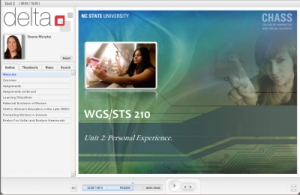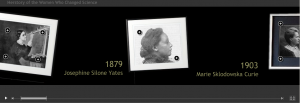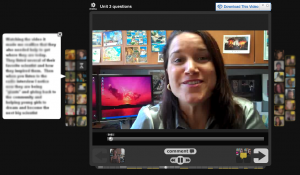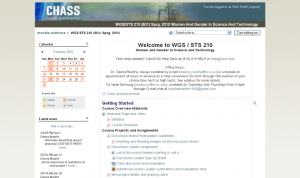Interactive Technology Facilitates Gender and Science Education
Elementary school kids were drawing their best version of Einstein, his hair sticking straight up, wearing a long white lab coat, holding a test tube filled with potent bubbling, green liquid. As the NCSU Distance Education (DE) students collected and showed these drawings, the kids recognized the drawings had one thing in common: the scientists are all male. It’s never occurred to these children that a scientist could be… a female.
These DE students were participating in an activist project created by Dr. Deena Murphy, an instructor in the College of Management and College of Humanities and Social Sciences. An activist project incorporates academic research as a tool for social action and change, and Murphy incorporated the “Draw-a-Scientist Test” into WGS/STS 210: Women and Gender in Science and Technology.
Murphy received an IDEA Grant from DELTA in 2009 to work with Ruth Smith, an Instructional Designer in DELTA’s Instructional Support Services (ISS), to create a DE section of WGS/STS 210.
WGS/STS 210 focuses on how social factors influence the way male and female science and engineering professionals experience the fields of science and technology. The course also focuses on the way people’s experiences as men and women affect their experiences with scientific and technological information.
In the past, Murphy’s class popularity has outnumbered the class limit. With assistance from DELTA, fifty extra spots are open for students wishing to take the course online.
Smith said that the online environment can encourage students to participate when they otherwise may not.
“It’s important to create an environment where students feel open to talk about gender issues. In class, students may not speak up because they are nervous or uncomfortable, but the online aspect allows students a comfortable platform to participate by applying what they’re learning to their own lives,” Smith said.
Smith and Murphy began working on the project in September 2009 for the spring semester. Although Murphy worked primarily with Smith, other DELTA employees assisted in creating unique multimedia offerings for DE students.
“This course wouldn’t be possible without Ruth. She was very helpful throughout the entire process, and even now continues to be very supportive,” Murphy said.

Conventional lectures were replaced with interactive PowerPoint presentations created in Articulate. Jennifer Schneider, a graduate student in psychology, created slides on intersexuality in science and technology.
Smith and Murphy also captured an interview with the textbook’s authors, then used a Flash Video tool created by David Tredwell, a DELTA Multimedia Specialist, to allow students to play the interview online. Tredwell’s tool allows students to easily navigate between key points of the video interview.
John Gordon and Darren Ley at Video Communication Services helped capture an audio recording of students performing a play that students were required to read, “Snow Brown and the Seven Detergents”, video interviews with important women in science such as Evelyn Fox Keller, and two guest lectures.
One guest lecture was given by Juliette Grimmett, a Rape Prevention Education Coordinator at the Women’s Center, who brought her students to a DELTA classroom to videotape an interactive class about activism on campus.

Murphy also created a Jeopardy game in conjunction with students from a previous class about women Nobel Prize winners and Smith created a collage (built using a tool called Vuvox) that provides a hyperlinked timeline of women in history who have made important contributions to science and technology.
This vast support team allowed Smith and Murphy to complete the project in just four months.
“Everyone at DELTA has been so supportive. I’ve met a lot of people other than Ruth and even though I wasn’t working with them one-on-one, they were always very informative and quick to help me with any problem,” Murphy said.
The course structure is also unique. Rather than having to come to campus to take a proctored midterm or final exam, students are given three mini-projects and a final project.
“[These projects] incorporate academic study with the practice of making research a tool for social action and change,” Smith said.
One project option students have is to raise money for brochures and flyers, create technical documents related to gender issues, and set up a booth in the Brickyard to talk to students about gender-related issues.
Or, students could go into an elementary school and design a presentation for children, discussing the relationship between gender and science and technology.
“Interactivity in the classroom setting is important to me, so trying to work out how to build in that level of interaction was difficult,” Murphy said.
To further increase interactivity, Smith and Murphy facilitated student-led online discussion.

“Students in groups of three to four each have to lead a week of discussions where they prepare questions and materials to guide the discussion, instead of simply responding to posts the instructor has posted. They do this both in Moodle and on VoiceThread. In VoiceThread, students can have discussions around images, videos and other media using audio, text or a Webcam.” Smith said.

Murphy found that Moodle was an easy-to-use tool to organize and display the various multimedia components.
“I took the Summer Institute 2009 sponsored by DELTA the week before I taught Human Resource Management in summer session one. I have since put more than seven sections for four different courses online using Moodle. I’m still learning some of the pieces but find it very intuitive and easy to use, much better than any of the other platforms,” Murphy said.
With student-led discussion in Moodle forums and VoiceThread, three mini-projects, a final activist project, and interactive PowerPoint presentations, Smith and Murphy created a unique level of online interactivity and communication.
- Categories:


